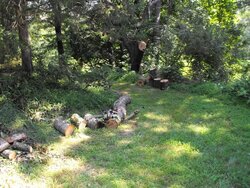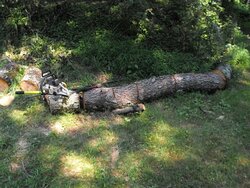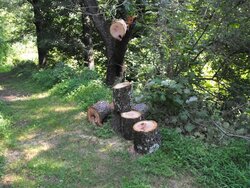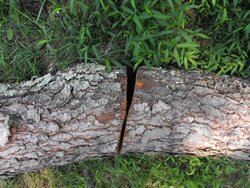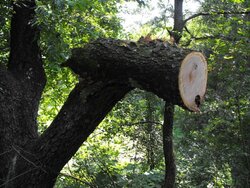I have a large Ash which had three trunks coming out of a common trunk at about 6' off the ground. The storm Sandy brought one of these down last October and to my surprise another came down a few days back due to the wet weather and the fact this trunk grew our on the horizontal before turning upward about 15' out from the main trunk. All the wood looks green with a small infestation of ants at the break point - the weak spot.
This trunk/branch was still attached to the main trunk, as said about 6' above the ground, but the top (about another 40') was down and resting on a path I have to my lower property (path for tractor and pickup travel, not just a foot path).
I now have most of it down on the ground and even cut into 16" or so rounds. The largest round being about 16" in diameter - my 16" chain saw will just reach across the thickest part.
I started at the top, cutting and dragging away branches down to a branch diameter of 2" or more. All of this up to the trunk being saved for firewood.
When I got to the main trunk I was faced with cutting a dangerous (I suppose more than a 1000 pounds) hunk of tree that was on the tree end holding on with shattered wood, and at the ground end nosed into the ground. So there was a large downward pressure on the 30' or so run of trunk. I started at the ground end and tried chain sawing up from underneath, assuming the cut would open as the round started to break away... ended up nonetheless with the saw locked in the cut when the tree dropped that end. I tried to get the saw out with a splitting wedge to no luck, only caused the cut to drop closer to the ground. I then went for my never starts well old light duty 16" Craftsman saw - it has a good chain on it. Surprise, it started in a few pulls and on gas at least 6 months old. I used the Craftsman saw to cut my Husky free.
So experienced I then used a long rock wedge to raise the tree enough to shove a branch underneath and cut a couple more rounds, at which point the angle of the trunk still hanging from the main tree as too steep to wedge upward. I think did the following, which worked and may in fact be a good-to-best way to go.
I first cut out a wedge on the top edge, a wedge like one uses to fell a tree. Then I cut from underneath. This wedge gave the tree some room to move downward as the lower cut moved toward a cut through. The open wedge would close, thus opening the underside cut more. I still did not cut all the way through, rather I moved up the trunk about 3 rounds (3 times 16") length and did the same.. continuing in this manner until I was up near the split at the main tree trunk. In this way I brought the full length (less a cleanup cut at the trunk) to the ground.
Is there a better and/or safer way to bring this type trunk to the ground? I am working alone and have only moderate male physical strength (I am big, but old). I do not have any machinery such as a backhoe to bring the trunk to the ground.
In any case I now have only to finish some cuts and bring all rounds to fireplace length, and yes bring the rounds to my electric splitter (near the house/shed) and split and stack. That will come to pass when the weather cools (albeit I found the temps reasonable before 8 Am - but still humid, boy can I sweat). I will move the pieces out of the way tomorrow so I can get my mowing tractor to my lower meadow - and mow before I have to cut 12" of tough field grass off. My mowing deck is a simple finish mower and goes only to about 6 or 7 " off the ground (tire) level.
This trunk/branch was still attached to the main trunk, as said about 6' above the ground, but the top (about another 40') was down and resting on a path I have to my lower property (path for tractor and pickup travel, not just a foot path).
I now have most of it down on the ground and even cut into 16" or so rounds. The largest round being about 16" in diameter - my 16" chain saw will just reach across the thickest part.
I started at the top, cutting and dragging away branches down to a branch diameter of 2" or more. All of this up to the trunk being saved for firewood.
When I got to the main trunk I was faced with cutting a dangerous (I suppose more than a 1000 pounds) hunk of tree that was on the tree end holding on with shattered wood, and at the ground end nosed into the ground. So there was a large downward pressure on the 30' or so run of trunk. I started at the ground end and tried chain sawing up from underneath, assuming the cut would open as the round started to break away... ended up nonetheless with the saw locked in the cut when the tree dropped that end. I tried to get the saw out with a splitting wedge to no luck, only caused the cut to drop closer to the ground. I then went for my never starts well old light duty 16" Craftsman saw - it has a good chain on it. Surprise, it started in a few pulls and on gas at least 6 months old. I used the Craftsman saw to cut my Husky free.
So experienced I then used a long rock wedge to raise the tree enough to shove a branch underneath and cut a couple more rounds, at which point the angle of the trunk still hanging from the main tree as too steep to wedge upward. I think did the following, which worked and may in fact be a good-to-best way to go.
I first cut out a wedge on the top edge, a wedge like one uses to fell a tree. Then I cut from underneath. This wedge gave the tree some room to move downward as the lower cut moved toward a cut through. The open wedge would close, thus opening the underside cut more. I still did not cut all the way through, rather I moved up the trunk about 3 rounds (3 times 16") length and did the same.. continuing in this manner until I was up near the split at the main tree trunk. In this way I brought the full length (less a cleanup cut at the trunk) to the ground.
Is there a better and/or safer way to bring this type trunk to the ground? I am working alone and have only moderate male physical strength (I am big, but old). I do not have any machinery such as a backhoe to bring the trunk to the ground.
In any case I now have only to finish some cuts and bring all rounds to fireplace length, and yes bring the rounds to my electric splitter (near the house/shed) and split and stack. That will come to pass when the weather cools (albeit I found the temps reasonable before 8 Am - but still humid, boy can I sweat). I will move the pieces out of the way tomorrow so I can get my mowing tractor to my lower meadow - and mow before I have to cut 12" of tough field grass off. My mowing deck is a simple finish mower and goes only to about 6 or 7 " off the ground (tire) level.



